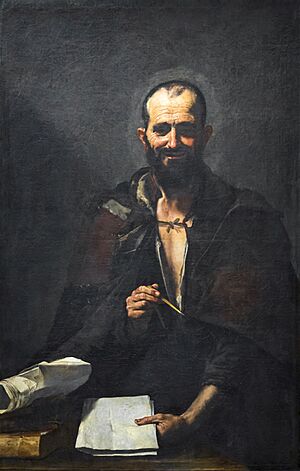Democritus (painting) facts for kids
Democritus is a famous painting by the Spanish artist Jusepe de Ribera. He painted it in 1630. Today, you can see this artwork at the Prado Museum in Madrid, Spain. Many people believe the painting shows an ancient Greek thinker named Democritus.
A Laughing Philosopher
For a long time, people thought this painting showed another famous thinker, Archimedes. This was because the person in the painting holds a compass and has papers with math symbols. But in 1962, an expert named Delphine Fitz Darby suggested it was actually Democritus.
Why Democritus? He was known as "the philosopher who laughs." The person in Ribera's painting has a clear, friendly smile. This makes Democritus a good match for the artwork. This painting might be the one called Philosopher with Compass. That painting belonged to the Duke of Alcalá, who was a big supporter of Ribera.
This artwork is one of the earliest in Ribera's series of "Ragged Philosophers." These paintings show thinkers dressed in simple, everyday clothes. The painting first appeared in official records in 1764 at El Escorial. Later, it became part of the collections at the Prado Museum, where it is still kept today.
What the Painting Shows
The painting shows the philosopher from the waist up. He looks like a poor person. In his right hand, he holds a compass. In his left hand, he has some papers with geometric shapes on them. You can see Ribera's signature and the date, "Jusepe de Ribera español / F 1630," on the spine of a book in the bottom right corner. Part of the painting on the right side seems to be cut off.
The most important parts of the painting are the philosopher's smiling face and his hands. His face has many deep wrinkles. His hands are bony with long fingers. Ribera painted these details very carefully and realistically. Light shines from the left side, lighting up the philosopher's body. A lighter area of paint around his head and a plain background make him stand out. This makes the painting look very real and deep.
Many people think Ribera used a real person as a model for this painting. He might have found someone ordinary on the street. Then, he painted them as if they were a very important person, like a nobleman or a king. An art expert, Nícola Spinosa, described it well. He said it was a true picture of a peasant from Naples. Ribera captured the look of ancient Greek people. He showed their lively and very human spirit.
See also
 In Spanish: Arquímedes (Ribera) para niños
In Spanish: Arquímedes (Ribera) para niños


